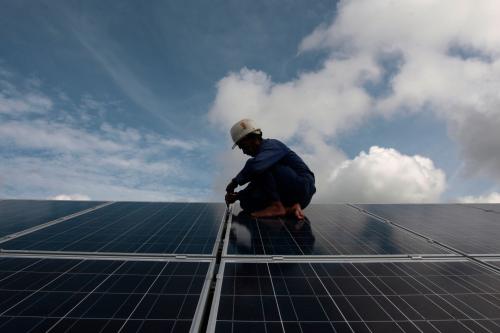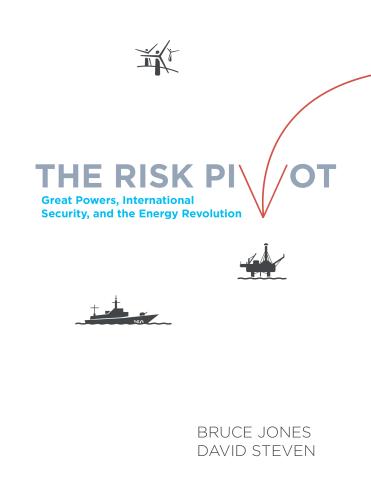Tour a few of Cornell Engineering’s laboratories and you’ll see some amazing prototypes with the power to change the energy landscape – devices that can suck carbon out of the air and turn it into electricity, new materials for batteries and solar cells, and plans for a unique geothermal system that can heat an entire 745-acre campus. However, the lack of a consistent energy policy and meaningful investment means many of these technologies may end up on the shelf instead of working in your home or community.
Long-term planning to scale up technology
It can take years for basic research to translate into deployable technology, and in many cases the research horizon does not align with policy. The first modern photovoltaic cell used in solar arrays was created in the 1950s, but the government became seriously interested two decades later when faced with the 1973 oil embargo. During this period Congress passed a bill ordering the installation of solar arrays on federal buildings, created the Solar Energy Research Institution and instituted several solar tax credits among other actions designed to improve U.S. energy independence. One of the results was that the average cost of solar plummeted from $76 per watt in 1977 to about $6 per watt in 1989.
As domestic oil production increased in the late 1970s and the cost of energy dropped for many Americans, political attention to alternative sources of energy – including solar technology – declined. Many of the programs authorized in the 1970s either expired or were repurposed.
Into this void, foreign manufacturers stepped in to continue to reduce the cost of solar panels. Today, the global price for solar is $0.45 per watt.
Despite these declining costs, just 0.9 percent of domestic energy production is attributable to solar compared to 77.6 percent to fossil fuels. While there are many factors driving this energy mix, a lack of a consistent, long-term energy policy created a political ebb and flow that limits what research institutions can accomplish while contributing to the persistence of fossil fuels as a primary energy source.
significant capital investment REQUIRED
Unlike other industries that rely on manufacturing, such as medical equipment and consumer electronics, scalable energy technologies incur enormous capital costs.
A project we are piloting at Cornell applies enhanced geothermal technology to a region that was previously not thought suitable – thereby opening up the possibility for a new geothermal industry that could serve our largest population centers on the East Coast. Just like a biomedical company must develop a working prototype for a new heart-assist device in order to demonstrate its value, we too must engineer an actual working system. But with capital costs in the hundreds of millions, funding the project is a daunting task.
There are few funding sources available to bridge the gap between basic energy research and commercial deployment. Those few that exist are generally government supported and are crucial to the development of early stage technology like enhanced geothermal. One such program is the Defense Advanced Research Projects Agency (DARPA), which in the mid 1970s invested in the development of gallium arsenide, a semiconductor that offers several advantages over silicon, depending on the application. As a result of DARPA’s $600 million investment, gallium arsenide is now a fixture in cellphones, computers, and commercial solar cells. It pays dividends when the government acts as a venture capitalist, particularly when the time horizon for returns is too long for private investors.
few incentives for uptake
Unlike other industries, the energy sector must overcome massive inertia to commercialize new technologies, with utility companies and consumers often having little incentive to adopt them.
The auto industry is a perfect example, where technology exists for both electric and hydrogen fuel cell cars – both zero-carbon emission alternatives to traditional transportation. President Obama’s 2011 launch of policies supporting electric vehicles, including a tax credit worth $7,500, could not counteract the enormous investment that’s already been made in how we fuel our cars. There is no incentive to replace gas pumps with charging stations, even though the battery technology exists. Coupled with plummeting gas prices, the goal of getting 1 million electric vehicles on the road by 2015 was unattainable.
In the case of geothermal, there are no national guidelines indicating how much it should be contributing to total energy production. Support for geothermal projects in the form of loan guarantees, lending support, or cooperative agreements has been inconsistent since the 1970s and a tax credit for geothermal developers expired in 2016 – the same year a new energy bill stalled in Congress that may have boosted funds directed at geothermal projects. This uncertainty makes geothermal less attractive to investors and utilities.
In the more than 60 years we’ve recognized energy as an important societal problem, we’ve failed to come up with the means and determination to change our reliance on fossil fuels. Researchers in universities and labs across the country will continue to innovate and find new ways to make energy more efficient, cheap, resilient to natural disasters, and less damaging to the environment. It is essential that we partner with government and policymakers to create a pipeline for these innovations to reach the market, so that we can ensure a sustainable energy future.
The Brookings Institution is committed to quality, independence, and impact.
We are supported by a diverse array of funders. In line with our values and policies, each Brookings publication represents the sole views of its author(s).










Commentary
Lack of long-term U.S. energy plan impedes transformative technology
May 22, 2018